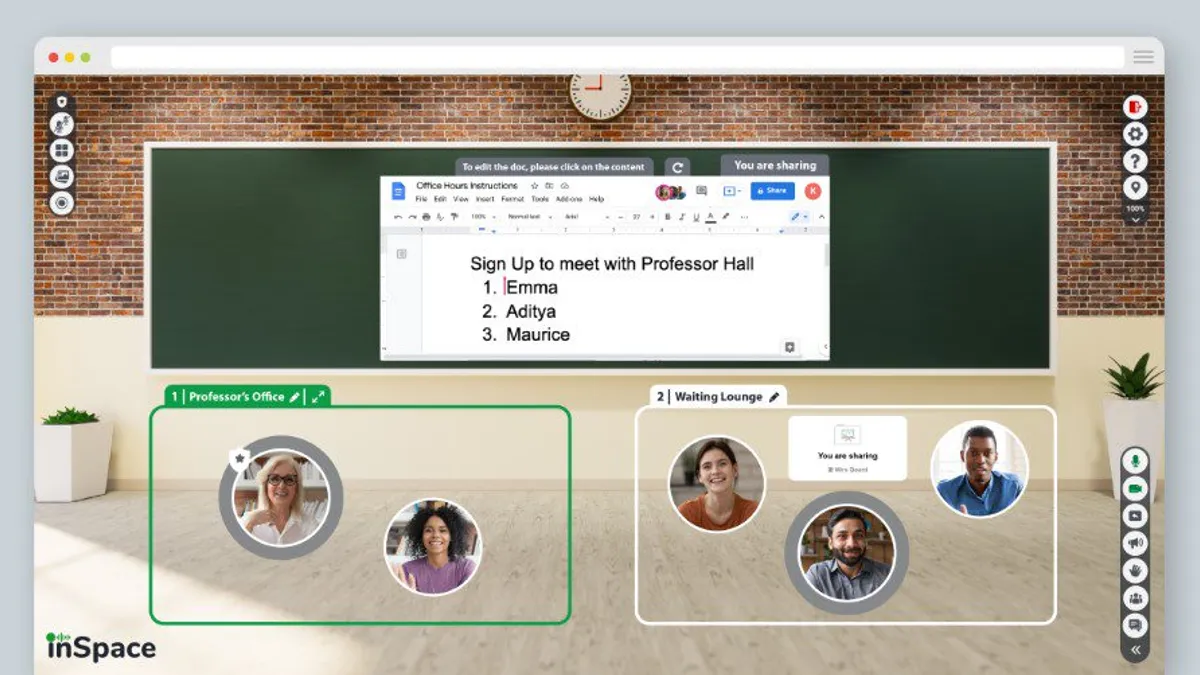Dive Brief:
- Virtual education communication platform InSpace on Wednesday announced full integration with the learning management system Canvas, which InSpace's CEO said she hopes will enable the platform to grow its user base.
- One-year-old InSpace says it's currently used by educators at more than 100 colleges and K-12 schools. Over 6,000 schools and universities in 70-plus countries use the fast-growing Canvas learning management system.
- InSpace is integrating its product with other learning management systems, as well. Its CEO expects additional announcements soon.
Dive Insight:
The integration reflects growth efforts and staying power among remote learning products born amid the pandemic, according to edtech sector experts. It fits into a trend of vendors, investors and educators trying to reshape the market in the wake of colleges' rushed move to fully remote learning after the coronavirus began to spread in the spring of 2020 — and educators' frustrations with existing tools' limitations.
Engageli, another digital learning platform for colleges designed as an alternative to Zoom, raised $33 million in a Series A funding round, it said in May. That brought its total raised to $47 million.
"It’s a sign of the new permanence of virtual/remote learning solutions by schools," Trace Urdan, managing director at investment banking and consulting firm Tyton Partners, said in an email.
InSpace bills itself as a "socially intuitive video conferencing platform" created by educators. It tries to replicate the in-classroom experience — where students can move around, form groups, find study spaces and share content — more closely than many better-known video-conferencing platforms.
Students and professors can use video icons to move themselves around virtual spaces, mimicking the way they'd navigate physical spaces. Speakers grow louder or softer as they approach each other, another effect modeled after the real world. The platform includes other features like multi-channel chat and virtual office hours.
InSpace has been growing quickly through word of mouth, said CEO Narine Hall, who is a professor of data science and machine learning at Champlain College in Vermont. Word of it initially spread through colleges' language and psychology departments, where group work is often popular in classes, Hall said. Integrating with Canvas and other learning management systems means users can access the platform with less friction.
Video conferencing is a crowded space at the moment. InSpace is seeking to stand out by focusing specifically on the needs of educators. They need tools to digitize classrooms without disrupting existing processes that they know work, Hall said.
"We have years of experience managing the classroom and creating those teachable moments for students," Hall said. "To be able to organically and correctly do this online is so critical for this transition."
For Canvas, the integration adds functionality. Students expect seamless experiences for a number of activities, including from the schools they attend, Mitch Benson, chief product officer at the learning management system's owner, Instructure, said in a statement.
But the integration announced Monday isn't a sea change in the market, and it doesn't guarantee that InSpace will be widely adopted. Canvas integrates with multiple systems that have overlapping functionality, including Zoom, Canvas's own Studio communications tool, Harmonize and Microsoft Teams, according to Phil Hill, partner at ed tech consulting firm MindWires.
"The InSpace integration could be useful, but in a small-ball kind of way," Hill said in an email.
For learning management systems, integrating different platforms and technologies can also be a way of testing new features and gathering information, according to Hill. It can help them decide whether to buy a company or build an in-house competitor to its products.














